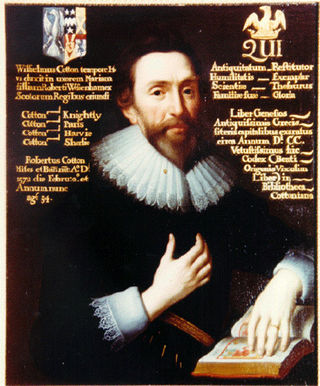
The Smith baronetcy, of Edmondthorpe (Edmundthorpe) in Leicestershire, was created on 20 March 1661 in the Baronetage of England for Edward Smith. He represented Leicestershire in the 1653 Barbon's Parliament. [1]

The Smith baronetcy, of Edmondthorpe (Edmundthorpe) in Leicestershire, was created on 20 March 1661 in the Baronetage of England for Edward Smith. He represented Leicestershire in the 1653 Barbon's Parliament. [1]

Baron Hazlerigg, of Noseley in the County of Leicester, is a title in the Peerage of the United Kingdom. It was created in 1945 for Sir Arthur Hazlerigg, 13th Baronet. He had previously served as Lord Lieutenant of Leicestershire. As of 2023 the title is held by his great-grandson, the fourth Baron, who succeeded his father in 2022.

There have been three Baronetcies created for persons with the surname Cotton, all in the Baronetage of England. One creation is extant as of 2008.

There have been six baronetcies created for persons with the surname Smyth, two in the Baronetage of England, one in the Baronetage of Great Britain, one in the Baronetage of Ireland and two in the Baronetage of the United Kingdom. One creation is extant as of 2010.

The Baronetcy of Hartopp of Freathby was created in on 3 December 1619 in the Baronetage of England for Edmund Hartopp, High Sheriff of Leicestershire 1618–9. He represented the parliamentary constituency of Leicestershire 1628–9. His grandson, the third Baronet represented the county 1679–81. The Baronetcy became extinct in 1762 when the estates passed by the female line to Cradock-Hartopp.

The Cradock-Hartopp Baronetcy, of Freathby in the County of Leicester and of Four Oaks Hall in the County of Warwick, was a title in the Baronetage of Great Britain. It was created on 12 May 1796 for Edmund Cradock-Hartopp, Member of Parliament for Leicestershire. Born Edmund Bunney, he was the husband of Anne Hurlock, granddaughter and heiress of Sir John Hartopp, 4th Baronet, of Freathby. On his marriage in 1777 he assumed the surname of Cradock-Hartopp in lieu of his patronymic according to the wills of his uncle Joseph Cradock and his wife's grandfather. His eldest surviving son Edmund, the second Baronet, died childless and was succeeded by his younger brother, William, the third Baronet. The title then descended from father to son until the death of his grandson, Charles, the fifth Baronet, in 1929.

The Smith, later Smyth, Smijth, Bowyer-Smijth and Bowyer-Smyth Baronetcy, of Hill Hall in the County of Essex, was created on 28 November 1661 for Thomas Smith. The current holder is the fifteenth Baronet.
There have been two baronetcies created for persons with the surname Cave, one in the Baronetage of England and one in the Baronetage of the United Kingdom. Both creations are extant as of 2008.

There have been twenty one baronetcies created for persons with the surname Williams, eight in the Baronetage of England, three in the Baronetage of Great Britain and ten in the Baronetage of the United Kingdom. Only six of the creations are extant as of 2017.
There have been seven baronetcies created for persons with the surname Powell, five in the Baronetage of England and two in the Baronetage of the United Kingdom. Only one creation is extant as of 2007.
The Villiers Baronetcy, of Brooksby, in the County of Leicester was created in the baronetage of England on 19 July 1619 for William Villiers of Brokesby, Leicestershire. A member of the prominent Villiers family, he was the son of George Villiers, brother of Sir Edward Villiers,, and the half-brother of George Villiers, 1st Duke of Buckingham, Christopher Villiers, 1st Earl of Anglesey, and John Villiers, 1st Viscount Purbeck. He was high sheriff of Leicestershire in 1609. The third baronet sat as member of parliament for Leicester from 1698 to 1701. On his death in 1712 the title became extinct.
There have been three baronetcies created in the Baronetage of England for members of the Skipwith family of Skipwith, Yorkshire, which relocated to Lincolnshire in the 14th century. They were a successful court family, with one member, Margaret Skipwith, seen as a possible queen of England after the death of Henry VIII's third wife, Jane Seymour. One creation of the baronetcy is extant as of 2008.

There have been four baronetcies created for members of the ancient House of Beaumont, all in the Baronetage of England. All four creations are extinct or dormant.
Sir Thomas Beaumont, 1st Baronet was an English politician.
Three baronetcies were created for different families bearing the name of Halford, but related to one another. The first baronetcy was created in 1641 for Richard Halford in the Baronetage of England. It became extinct in 1780 with the death of the seventh and last baronet. The second baronetcy was created in 1706, also in the Baronetage of England, but became extinct in 1720 in the second generation. The third and last baronetcy was created in 1809 in the Baronetage of the United Kingdom for a prominent physician descended maternally from the fifth Baronet of the previous creation. It too became extinct with the death of the fourth Baronet in 1897.

There have been four baronetcies created for persons with the surname Cope.

The Golding Baronetcy, of Colston Bassett in the County of Nottingham, was a title in the Baronetage of England. It was created on 27 September 1642 for Edward Golding. The title became extinct on the death of the third Baronet in 1715.
Sir John Pretyman, 1st Baronet of Loddington, Leicestershire was an English politician.
There have been two baronetcies created for persons with the surname Pickering, one in the Baronetage of Nova Scotia and one in the Baronetage of England. Both creations are extinct.
Sir Edward Smith, 1st Baronet was an English landowner and politician who sat in the House of Commons in 1653.
Sir John Skeffington, 2nd Baronet was an English landowner and politician, elected to the House of Commons in 1626. He was fined a high sum for supporting the Royalist cause in the English Civil War.